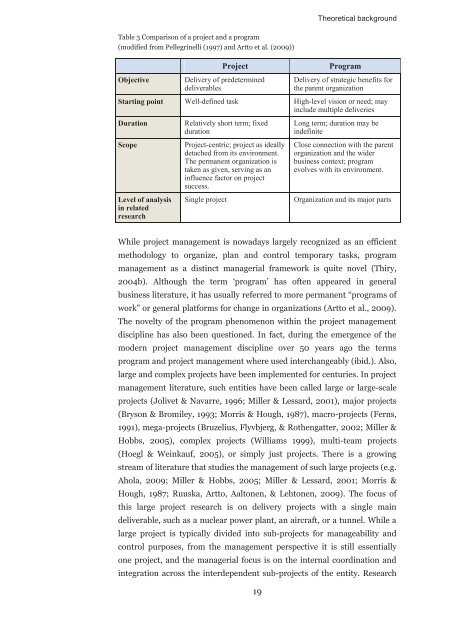Boundary activities and readiness for ... - Projekti-Instituutti
Boundary activities and readiness for ... - Projekti-Instituutti
Boundary activities and readiness for ... - Projekti-Instituutti
Create successful ePaper yourself
Turn your PDF publications into a flip-book with our unique Google optimized e-Paper software.
Theoretical background<br />
Table 3 Comparison of a project <strong>and</strong> a program<br />
(modified from Pellegrinelli (1997) <strong>and</strong> Artto et al. (2009))<br />
Objective<br />
Project<br />
Delivery of predetermined<br />
deliverables<br />
Program<br />
Delivery of strategic benefits <strong>for</strong><br />
the parent organization<br />
Starting point Well-defined task High-level vision or need; may<br />
include multiple deliveries<br />
Duration<br />
Scope<br />
Level of analysis<br />
in related<br />
research<br />
Relatively short term; fixed<br />
duration<br />
Project-centric; project as ideally<br />
detached from its environment.<br />
The permanent organization is<br />
taken as given, serving as an<br />
influence factor on project<br />
success.<br />
Single project<br />
Long term; duration may be<br />
indefinite<br />
Close connection with the parent<br />
organization <strong>and</strong> the wider<br />
business context; program<br />
evolves with its environment.<br />
Organization <strong>and</strong> its major parts<br />
While project management is nowadays largely recognized as an efficient<br />
methodology to organize, plan <strong>and</strong> control temporary tasks, program<br />
management as a distinct managerial framework is quite novel (Thiry,<br />
2004b). Although the term ‘program’ has often appeared in general<br />
business literature, it has usually referred to more permanent “programs of<br />
work” or general plat<strong>for</strong>ms <strong>for</strong> change in organizations (Artto et al., 2009).<br />
The novelty of the program phenomenon within the project management<br />
discipline has also been questioned. In fact, during the emergence of the<br />
modern project management discipline over 50 years ago the terms<br />
program <strong>and</strong> project management where used interchangeably (ibid.). Also,<br />
large <strong>and</strong> complex projects have been implemented <strong>for</strong> centuries. In project<br />
management literature, such entities have been called large or large-scale<br />
projects (Jolivet & Navarre, 1996; Miller & Lessard, 2001), major projects<br />
(Bryson & Bromiley, 1993; Morris & Hough, 1987), macro-projects (Ferns,<br />
1991), mega-projects (Bruzelius, Flyvbjerg, & Rothengatter, 2002; Miller &<br />
Hobbs, 2005), complex projects (Williams 1999), multi-team projects<br />
(Hoegl & Weinkauf, 2005), or simply just projects. There is a growing<br />
stream of literature that studies the management of such large projects (e.g.<br />
Ahola, 2009; Miller & Hobbs, 2005; Miller & Lessard, 2001; Morris &<br />
Hough, 1987; Ruuska, Artto, Aaltonen, & Lehtonen, 2009). The focus of<br />
this large project research is on delivery projects with a single main<br />
deliverable, such as a nuclear power plant, an aircraft, or a tunnel. While a<br />
large project is typically divided into sub-projects <strong>for</strong> manageability <strong>and</strong><br />
control purposes, from the management perspective it is still essentially<br />
one project, <strong>and</strong> the managerial focus is on the internal coordination <strong>and</strong><br />
integration across the interdependent sub-projects of the entity. Research<br />
19









